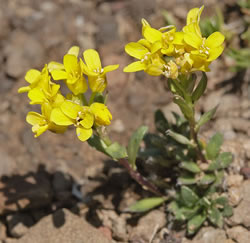Southwestern Region
Botanists Call Them “Novelties”
 Heil’s alpine whitlowgrass remained undiscovered until 2008. It is only about 3 inches tall. Photo by Steve O’Kane at http://nmrareplants.unm.edu.
Heil’s alpine whitlowgrass remained undiscovered until 2008. It is only about 3 inches tall. Photo by Steve O’Kane at http://nmrareplants.unm.edu.
 Heil’s alpine whitlowgrass grows above timberline in the Pecos Wilderness in northern New Mexico. Photo by Scott Surgent at http://www.surgent.net.
Heil’s alpine whitlowgrass grows above timberline in the Pecos Wilderness in northern New Mexico. Photo by Scott Surgent at http://www.surgent.net.
 Capitan Peak alumroot is an inconspicuous plant, but also fairly common in its very limited habitat in the Capitan Mountains of southeastern New Mexico. Photo by Patrick Alexander at http://polyploid.net.
Capitan Peak alumroot is an inconspicuous plant, but also fairly common in its very limited habitat in the Capitan Mountains of southeastern New Mexico. Photo by Patrick Alexander at http://polyploid.net.
 Capitan Peak alumroot grows in rocky talus of north-facing slopes at about 9,000 feet. Photo by Patrick Alexander at http://polyploid.net.
Capitan Peak alumroot grows in rocky talus of north-facing slopes at about 9,000 feet. Photo by Patrick Alexander at http://polyploid.net.
 Cloudcroft scorpionweed is a fairly big plant, but it is extremely rare. Photo by Bob Sivinski at http://nmrareplants.unm.edu.
Cloudcroft scorpionweed is a fairly big plant, but it is extremely rare. Photo by Bob Sivinski at http://nmrareplants.unm.edu.
Botanists have been exploring North America for more than 250 years and they have found about 20,000 species of vascular plants. With that many plants, you would think botanists had found them all; but you would be wrong. About 40 new plant species are discovered each year in North America. Botanists call these new species “novelties” and the hope of finding new novelties keeps botanists exploring the remote nooks and crannies of North America year after year.
Some of the best and most remote nooks and crannies are on our national forests. For instance, botanists have discovered three new species on national forests in New Mexico in the last few years. Heil’s alpine whitlowgrass was discovered on the Santa Fe National Forest and Capitan Peak alumroot and Cloudcroft scorpionweed were discovered on the Lincoln National Forest.
Ken Heil and Steve O’Kane are expert botanists who have been exploring New Mexico for decades. They packed on horse into the remotest parts of the Pecos Wilderness on the Santa Fe National Forest in July 2008. While searching the alpine tundra above 12,000 feet, they found a tiny little mustard about 3 inches tall that they recognized as a whitlowgrass (Draba spp.). However, they had never seen a whitlowgrass like this one and suspected it might be a new species. They sent specimens to Ishan Al-Shehbaz at the Missouri Botanical Garden who is an expert on these plants. Al-Shehbaz confirmed the plants were a new species and published the name Draba heilii in 2009.
Patrick Alexander is a doctoral candidate at New Mexico State University. He is an avid explorer, skilled photographer, and keenly observant botanist. While hiking in the Capitan Mountain Wilderness on the Lincoln National Forest in 2006, he found an alumroot (Heuchera spp.) he could not identify using the Flora of New Mexico. But, perhaps this species was just new in New Mexico and already well known elsewhere. Further study revealed that indeed this was a new undescribed alumroot with the closest similar alumroots being found in the Pacific Northwest and adjacent Canada. Alexander published the name Heuchera woodsiaphila in 2008.
Dwayne Atwood is a former Forest Service botanist, assistant curator of the herbarium at Brigham Young University, and expert on scorpionweeds (Phacelia spp.). He was studying scorpionweed specimens from all over the Southwest when he found one that just did not fit. The plant had been collected in the 1960s along U.S. Highway 82 near the town of Cloudcroft on the Lincoln National Forest. He visited the forest in 1993 and found plants in the same general area as the one collected in the 1960s. He concluded this was a new species and told other botanists to be looking for it. But, no more plants were found and he ultimately decided he could delay publication on longer. After all, perhaps recognition with a name would inspire more botanists to look for this elusive plant. He published the name Phacelia cloudcroftensis in December of 2007. In 2009, botanist Bob Sivinski found and photographed the Cloudcroft scorpionweed at a completely new location on the Lincoln National Forest helping confirm that this new species really does exist.
Are there more botanical novelties waiting to be discovered on New Mexico national forests? “By all means yes,” is the universal response from New Mexico botanists.

